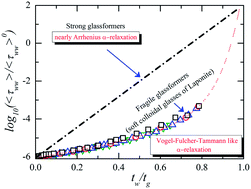Investigation of the dynamical slowing down process in soft glassy colloidal suspensions: comparisons with supercooled liquids†
Abstract
The primary and secondary relaxation timescales of aging colloidal suspensions of Laponite are estimated from intensity autocorrelation functions obtained in dynamic light scattering (DLS) experiments. The dynamical slowing down of these relaxation processes are compared with observations in fragile supercooled liquids by establishing a one-to-one mapping between the waiting time since filtration of a Laponite suspension and the inverse of the temperature of a supercooled liquid that is rapidly quenched towards its glass transition temperature. New timescales associated with primary and secondary relaxation processes, such as the characteristic timescale associated with the slowdown of the secondary relaxation process and the glass transition time, are extracted to describe the phenomenon of dynamical arrest in Laponite suspensions. In results that are strongly reminiscent of those extracted from supercooled liquids approaching their glass transitions, it is demonstrated that a strong coupling exists between the primary and secondary relaxation processes of aging Laponite suspensions in the cage-forming regime. Furthermore, the experimental data presented here clearly demonstrate the self-similar nature of the aging dynamics of Laponite suspensions within a range of sample concentrations.


 Please wait while we load your content...
Please wait while we load your content...